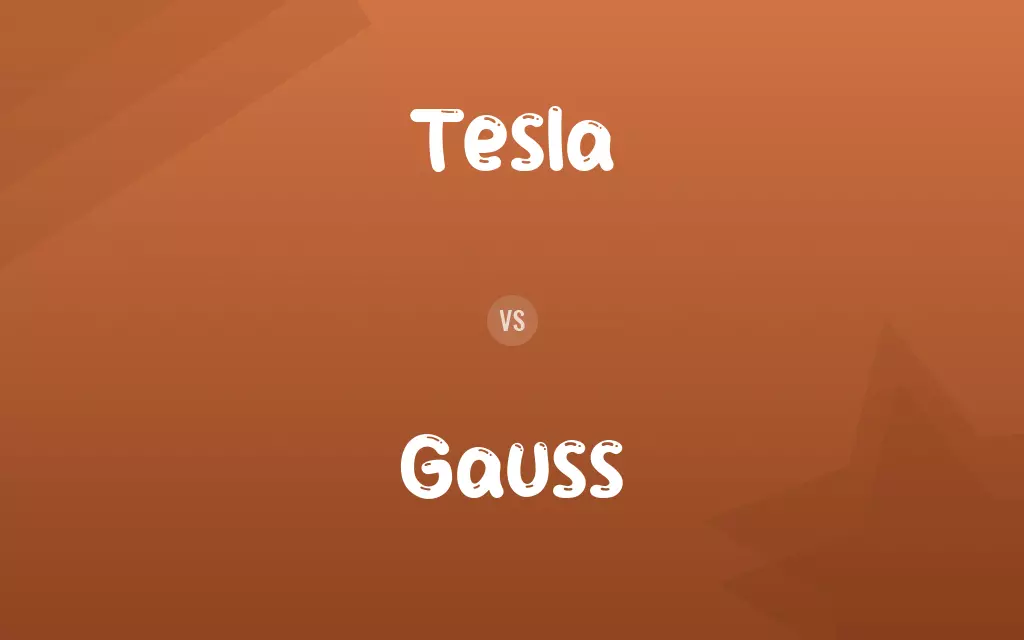Tesla vs. Gauss: Difference and Comparison
Edited by Muazma Batool — By Muneeza Rehman — Updated on September 25, 2023
Tesla and gauss are units of magnetic field strength; tesla is the SI unit, while gauss is from the CGS system; 1 tesla equals 10,000 gauss.

Difference Between Tesla and Gauss
Tesla and gauss are both used to describe magnetic field strength or magnetic flux density. However, they originate from two different systems of measurement. The tesla is the standard unit of magnetic flux density in the International System of Units (SI), named in honor of the inventor Nikola Tesla. Being an SI unit, the tesla is widely used in scientific research, technical applications, and academic settings.
Muneeza Rehman
Sep 25, 2023
Gauss, on the other hand, belongs to the Centimetre-Gram-Second (CGS) system of units. Named after the mathematician and physicist Carl Friedrich Gauss, it's less common in contemporary contexts but is still found in certain specialized fields and historical literature. While both tesla and gauss measure the same physical quantity, they differ in magnitude.
Muazma Batool
Sep 25, 2023
When comparing the two, 1 tesla is equivalent to 10,000 gauss. This means that the tesla is a much larger unit than the gauss. For everyday applications, the gauss might be a more comprehensible unit because magnetic fields on Earth, like the Earth's magnetic field, are typically measured in gauss or milligauss due to their smaller magnitudes.
Muneeza Rehman
Sep 25, 2023
However, in many modern contexts, especially those related to advanced scientific research or industries, the tesla is the preferred unit due to its alignment with the SI system. Ultimately, the choice between tesla and gauss often depends on the context of the measurement, historical precedents in a particular field, and the scale of the magnetic fields being discussed.
Kaitlyn
Sep 25, 2023
Tesla vs. Gauss Comparison Chart
Measurement System
International System of Units (SI)
Centimetre-Gram-Second (CGS) system
Muneeza Rehman
Sep 25, 2023
Definition
SI unit of magnetic flux density
CGS unit of magnetic flux density
Muazma Batool
Sep 25, 2023
Tesla vs. Gauss Definitions
◉Tesla
SI unit for magnetic flux density.
The MRI machine operates at 3 tesla.
Muazma Batool
Sep 25, 2023
◉Gauss
Historically used in certain specialized fields.
Gauss is a traditional unit in geomagnetic studies.
Muneeza Rehman
Sep 25, 2023
◉Tesla
Named after inventor Nikola Tesla.
The tesla unit honors the contributions of Nikola Tesla to electromagnetism.
Kaitlyn
Sep 25, 2023
◉Gauss
Often used for smaller magnitudes of magnetic fields.
The ambient magnetic field here is about 0.4 gauss.
Leo
Sep 25, 2023
◉Tesla
Used in modern scientific and technical contexts.
The lab's magnet can produce a field of 2 tesla.
Muneeza Rehman
Sep 25, 2023
◉Gauss
Represents one maxwell per square centimeter.
The device detected a field of 150 gauss.
Kaitlyn
Sep 25, 2023
◉Tesla
Represents one weber per square meter.
The magnetic field strength was measured to be 0.5 tesla.
Olivia
Sep 25, 2023
◉Gauss
CGS unit for magnetic flux density.
Earth's magnetic field is approximately 0.5 gauss.
Muazma Batool
Sep 25, 2023
◉Tesla
Aligned with the International System of Units.
Scientists often use tesla for its compatibility with the SI system.
Kaitlyn
Sep 25, 2023
◉Gauss
Named after mathematician Carl Friedrich Gauss.
The gauss unit pays tribute to Gauss's work in magnetism.
Elijah
Sep 25, 2023
◉Tesla
The SI-derived unit of magnetic flux density, equal to the magnitude of the magnetic field vector necessary to produce a force of one newton on a charge of one coulomb moving perpendicular to the direction of the magnetic field vector with a velocity of one meter per second. It is equivalent to one weber per square meter. See Table at measurement.
Muneeza Rehman
May 03, 2023
◉Gauss
The centimeter-gram-second unit of magnetic flux density, equal to one maxwell per square centimeter.
Muneeza Rehman
May 03, 2023
◉Tesla
In the International System of Units, the derived unit of magnetic flux density or magnetic inductivity. Symbol: T
Muneeza Rehman
May 03, 2023
◉Gauss
The unit of magnetic field strength in CGS systems of units, equal to 0.0001 tesla.
Muneeza Rehman
May 03, 2023
◉Gauss
The C.G.S. unit of density of magnetic field, equal to a field of one line of force per square centimeter, being thus adopted as an international unit at Paris in 1900; sometimes used as a unit of intensity of magnetic field. It was previously suggested as a unit of magnetomotive force.
Muneeza Rehman
May 03, 2023
◉Tesla
United States electrical engineer and inventor (born in Croatia but of Serbian descent) who discovered the principles of alternating currents and developed the first alternating-current induction motor and the Tesla coil and several forms of oscillators (1856-1943)
Muneeza Rehman
May 03, 2023
◉Gauss
a unit of magnetic flux density equal to 1 maxwell per square centimeter
Muneeza Rehman
May 03, 2023
◉Gauss
German mathematician who developed the theory of numbers and who applied mathematics to electricity and magnetism and astronomy and geodesy (1777-1855)
Muneeza Rehman
May 03, 2023
Tesla vs. Gauss Frequently Asked Questions
Why might someone use gauss over tesla?
Gauss might be used for smaller magnetic fields, historical consistency, or in fields that traditionally use the CGS system.
Nolan
Sep 25, 2023
Is gauss still widely used today?
While tesla is more common due to the SI system, gauss is used in specific fields and historical contexts.
Muneeza Rehman
Sep 25, 2023
What do both tesla and gauss measure?
Both measure magnetic flux density or magnetic field strength.
Muneeza Rehman
Sep 25, 2023
Which unit is larger, tesla or gauss?
Tesla is larger; 1 tesla is equivalent to 10,000 gauss.
Muazma Batool
Sep 25, 2023
Are there other units for magnetic field strength?
Yes, but tesla and gauss are among the most recognized.
Muneeza Rehman
Sep 25, 2023
Why is the SI system preferred in many modern contexts?
The SI system offers a consistent and internationally recognized set of units, making it preferred for global scientific communication.
Muneeza Rehman
Sep 25, 2023
Who are the units named after?
Tesla is named after Nikola Tesla, and gauss is named after Carl Friedrich Gauss.
Kaitlyn
Sep 25, 2023
In which unit is Earth's magnetic field commonly described?
It's often described in gauss or milligauss due to its relatively small magnitude.
Lucas
Sep 25, 2023
Which unit is used in MRI machines?
Tesla is typically used, with many MRI machines operating in the range of 1 to 3 tesla.
Jonathan
Sep 25, 2023
Content Creators
Written by
Muneeza RehmanAt Comparisons.wiki, Muneeza skillfully navigates the vast sea of information, ensuring clarity and accuracy as the lead content editor. With a keen eye for detail, she curates every comparison to enlighten and engage readers.
Edited by
Muazma BatoolAs a content editor, Muazma Batool is not just a grammar guru but a creative mastermind who breathes life into every word. With an eagle eye for detail and a passion for storytelling, she transforms bland text into engaging content that captivates audiences and drives results.


































